Alternative Fuels in the Maritime Industry: Emissions Evaluation of Bulk Carrier Ships
Abstract
1. Introduction
2. Alternative Fuels in the Maritime Sector
3. Materials and Methods
3.1. Operational Profile
3.2. Base Ships
3.3. Fuels
3.4. Fuel Combinations for CO2eq Emissions
3.5. Estimation of Fuel Emissions
4. Results and Discussion
4.1. Potential Emissions Reductions
4.2. Comparative Analysis of CO2eq Emissions per Mass of Iron Ore
4.3. Comparative Analysis of CO2eq Emissions per Unit of Mass and per Distance Transported of Iron Ore
4.4. EEDI Coefficient
4.5. CII Coefficients
5. Conclusions
Author Contributions
Funding
Data Availability Statement
Conflicts of Interest
Abbreviations
| B | Beam |
| bioDiesel | Diesel form biomass |
| bioLNG | Natural gas (methane) from biomass |
| bioMeOH | Methanol from biomass |
| CAPEX | Capital Expenditure |
| CCS | China Classification Society |
| CH4 | Methane |
| CII | Carbon Intensity Indicator |
| CO2 | Carbon dioxide |
| CO2eq | Impact of different greenhouse gases in terms of the mass of CO2 |
| D | Depth |
| DWT | Deadweight Tonnage |
| EEDI | Energy Efficiency Design Index |
| EEXI | Energy Efficiency Existing Ship Index |
| EU | European Union |
| eDiesel | Synthetic diesel |
| eLNG | Synthetic natural gas (synthetic methane) |
| eMeOH | Synthetic methanol |
| GHG | Greenhouse gases |
| GT | Gross tonnage |
| GWP | Global Warming Potential |
| HFO | Heavy Fuel Oil |
| IGF Code | International Code of Safety for Ship Using Gases or Other Low-flashpoint Fuel |
| IMO | International Maritime Organization |
| IMSBC | International Maritime Solid Bulk Cargoes Code |
| LOA | Length overall |
| LBP | Length between perpendiculars |
| LNG | Liquified Natural Gas |
| m | Mass |
| MCR | Maximum Continuous Rating (%) |
| MDO | Marine Diesel Oil |
| MGO | Marine Gas Oil |
| MSC.1/Circ.1621 | Guidelines for the safety of ships using methyl/ethyl alcohol as fuel |
| N2O | Nitrous oxide |
| NOx | Nitric oxide (NO) and nitrogen dioxide (NO2) |
| OPEX | Operational expenditures |
| SOx | Sulfur dioxide (SO2) and sulfur trioxide (SO3) |
| TtW | Tank to Wake |
| VLOC | Very Large Ore Carrier |
| VLCC | Very Large Crude Carrier |
| VLSFO | Very Low Sulfur Fuel Oil |
| WtT | Well-to-Tank |
| Symbols | |
| Total mass of CO2eq | |
| Mass of CO2eq produced during TtW without methane slip | |
| Mass of CO2eq produced during TtW due to methane slip | |
| Total mass of CO2eq produced during TtW | |
| Total mass of CO2eq produced during WtT | |
| Mass of CO2eq per energetic unit in TtW | |
| Mass of CO2eq per unit of energy in WtT | |
| CH4 TtW GHG emission factor by slipped fuel i towards fuel consumer unit j | |
| CO2 TtW GHG emission factor by slipped fuel i towards fuel consumer unit j | |
| N2O TtW GHG emission factor by slipped fuel i towards fuel consumer unit j | |
| Non-combusted fuel (methane) coefficient as a percentage of the mass of the fuel i consumer unit j | |
| CH4 global warming potential | |
| CO2 global warming potential | |
| N2O global warming potential | |
| Lower Heating value | |
| Fuel consumed per engine at a specific regime of functioning in | |
| Unitary power of each engine | |
| Regime of functioning of each engine | |
| Specific Fuel Oil Consumption | |
| Reference speed of the vessel as calculated in the MEPC 79/15/Add.1 |
Appendix A
| SFOC (g/kWh) | G80ME-C10.5 [68] | G80ME-C10.5-GI [69] | G80-C10.5-LGIM [70] | 8L23/30H [71] | 8L23/30DF [72] | 8L23/30DF [72] |
|---|---|---|---|---|---|---|
| VLSFO 50% | 156.2 | |||||
| VLSFO 75% | 158.5 | |||||
| VLSFO 85% | 161.1 | |||||
| VLSFO 100% | 165.0 | |||||
| MGO 50% | 3.9 | 12.9 | 185.0 | |||
| MGO 75% | 3.0 | 9.9 | 185.0 | |||
| MGO 85% | 2.8 | 9.2 | 185.0 | |||
| MGO 100% | 2.5 | 8.2 | 185.0 | |||
| LNG 50% | 126.8 | 150.0 | ||||
| LNG 75% | 128.0 | 150.0 | ||||
| LNG 85% | 130.6 | 150.0 | ||||
| LNG 100% | 134.6 | 150.0 |
Appendix B
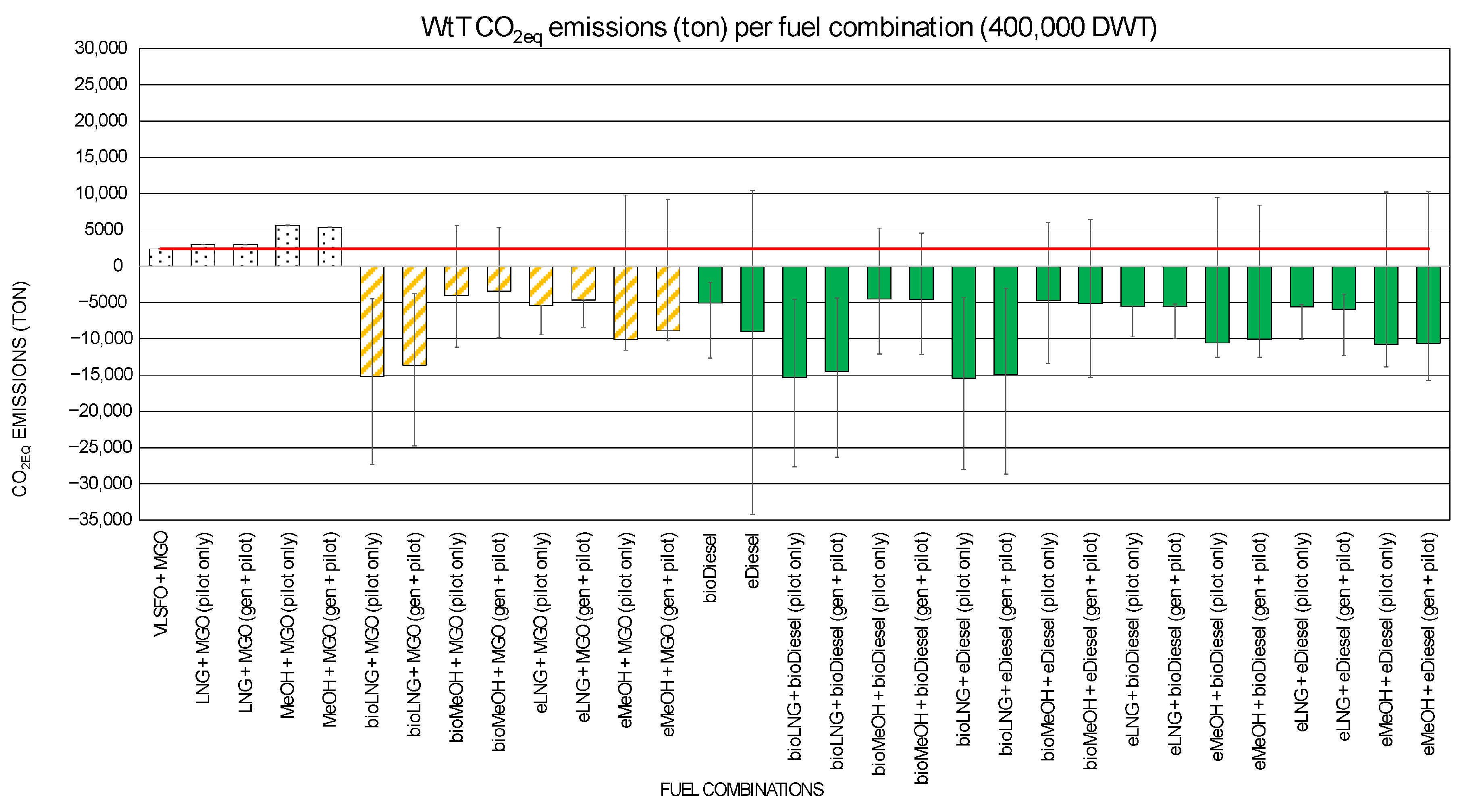
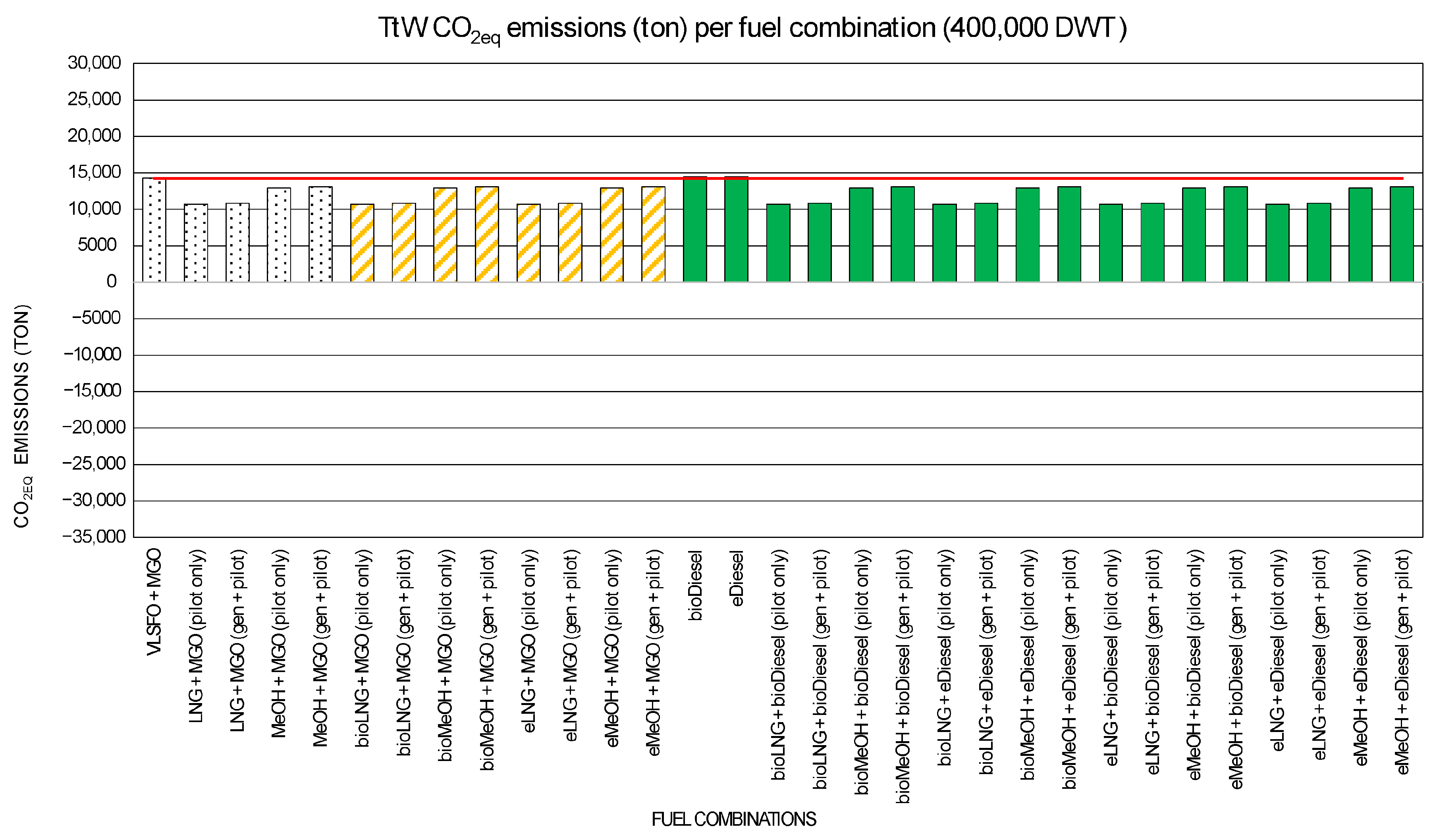
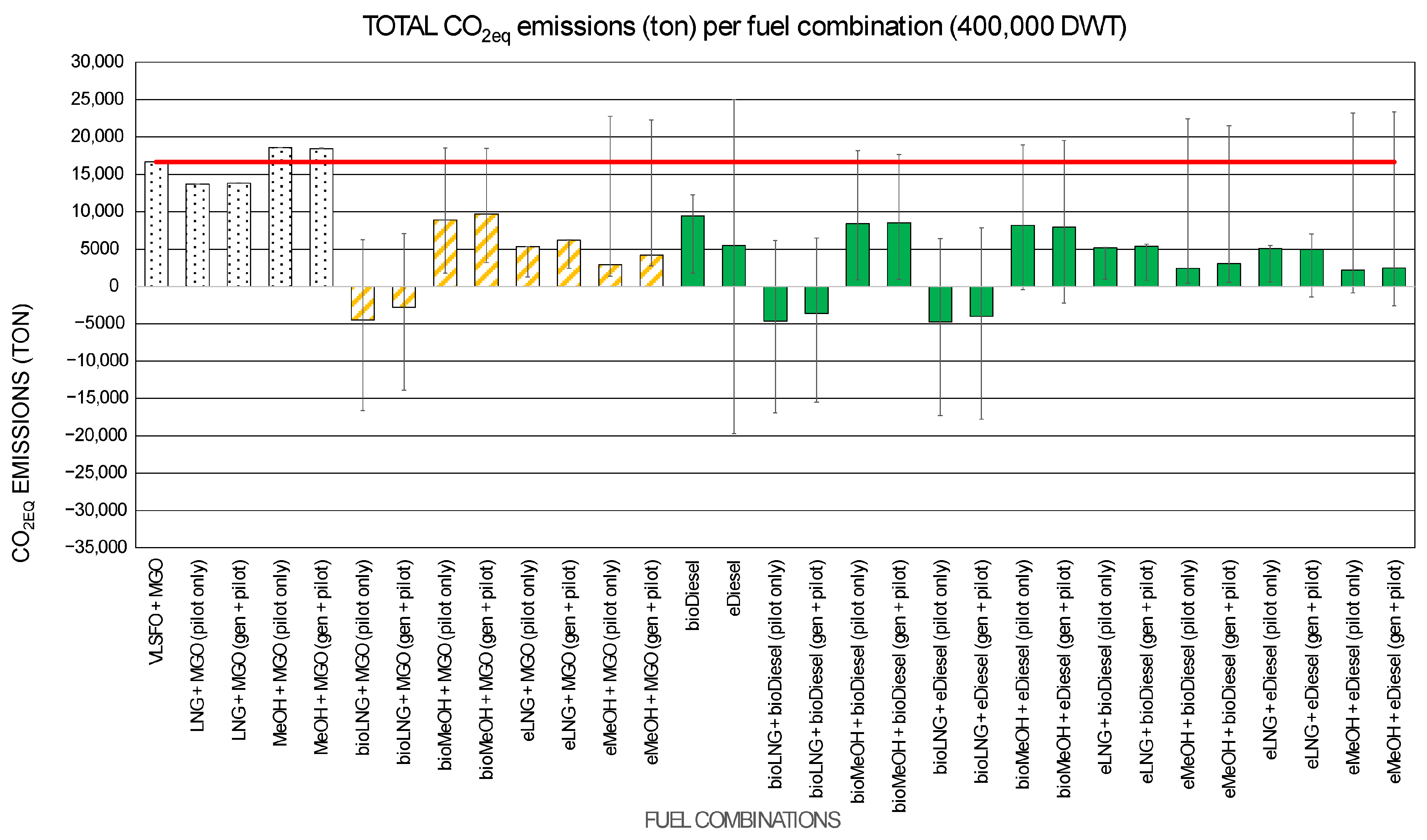
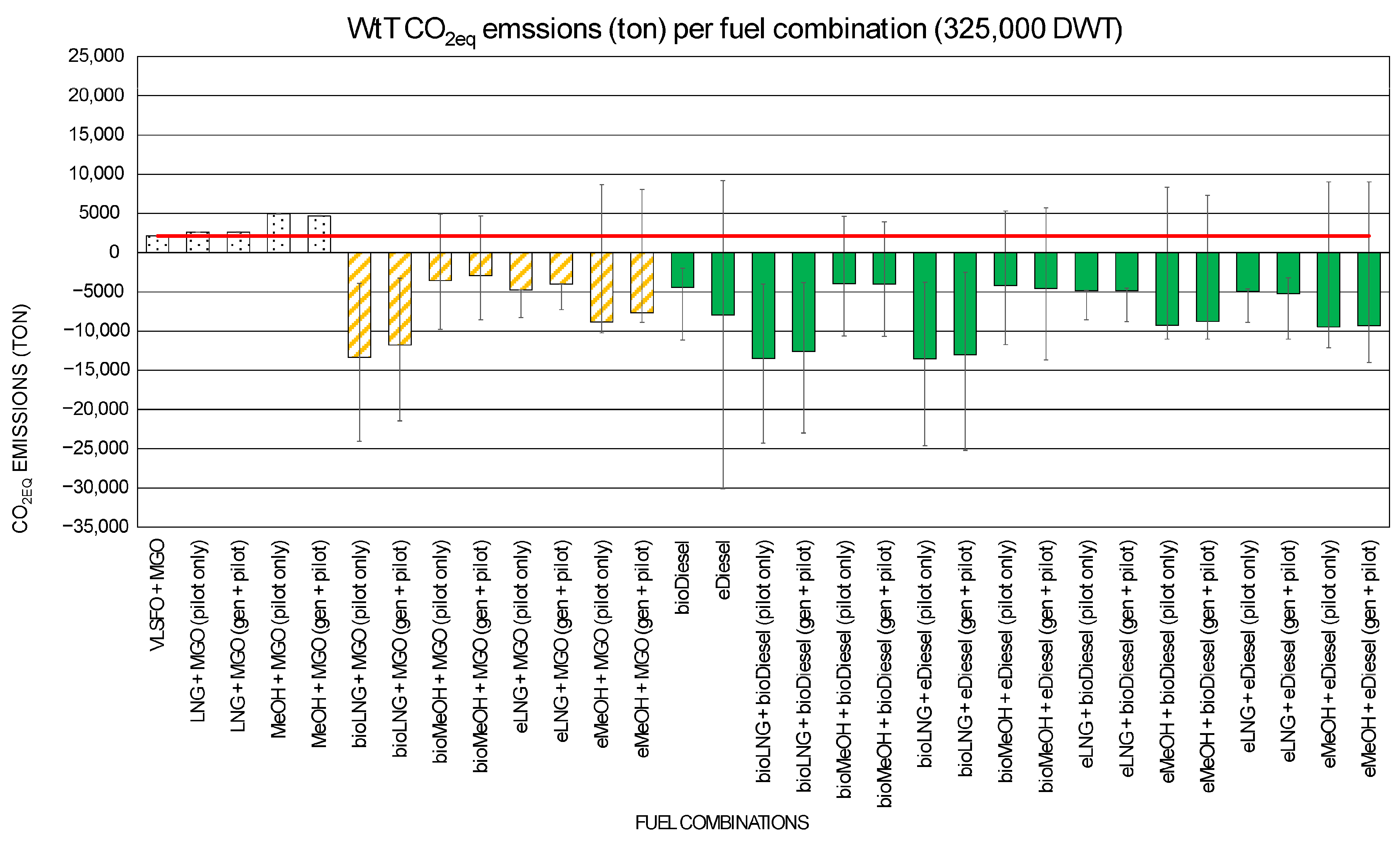

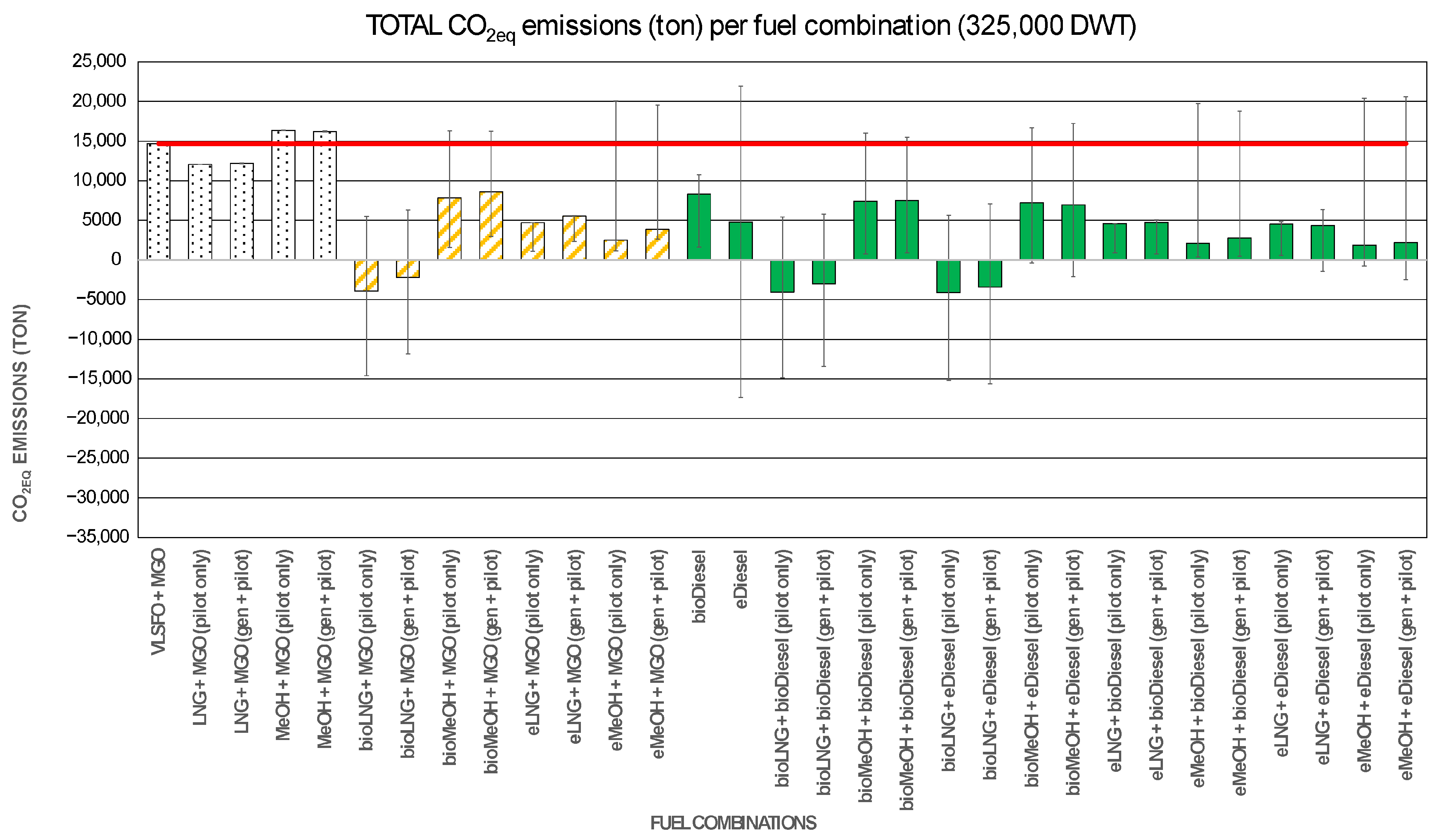

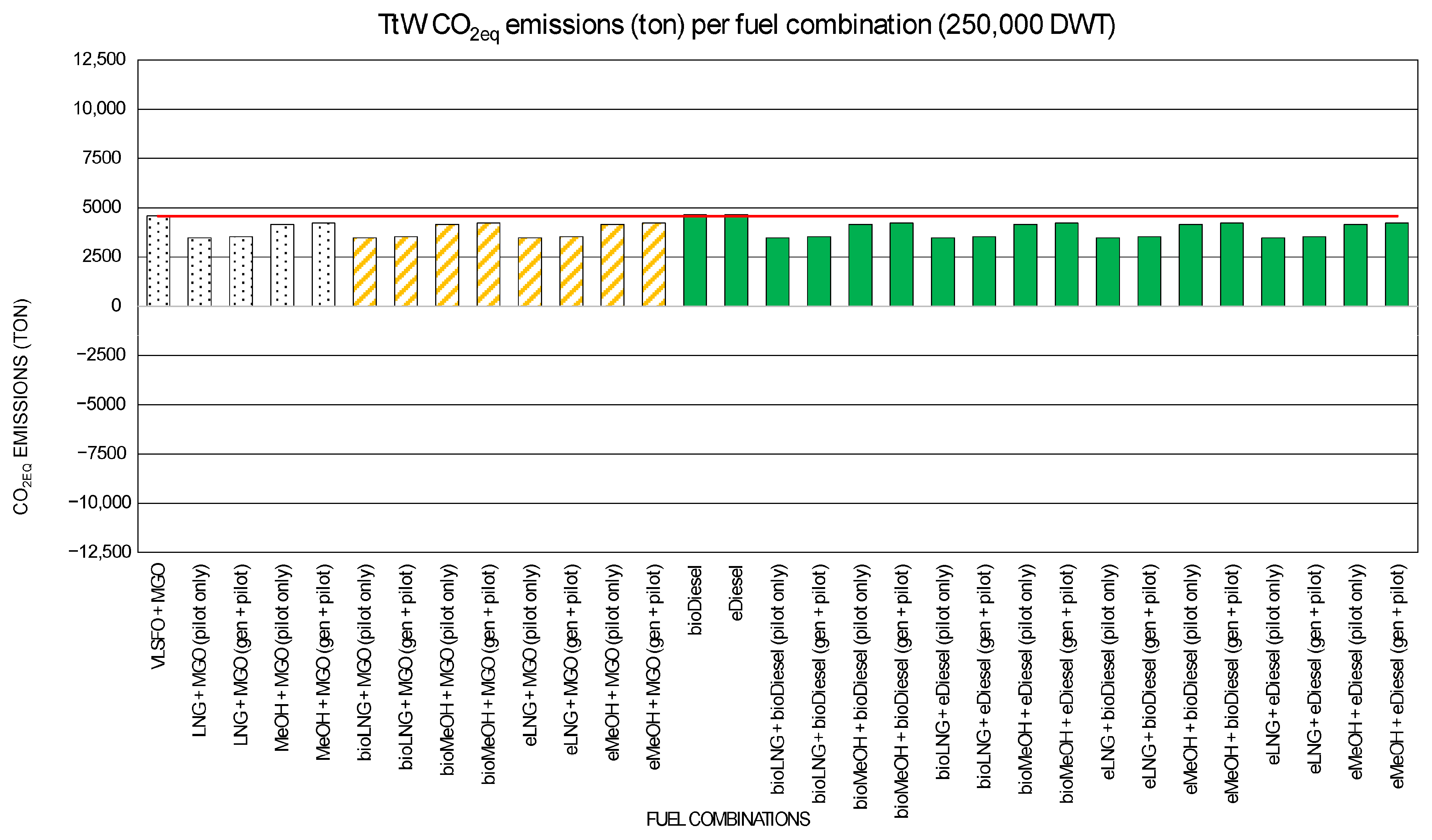
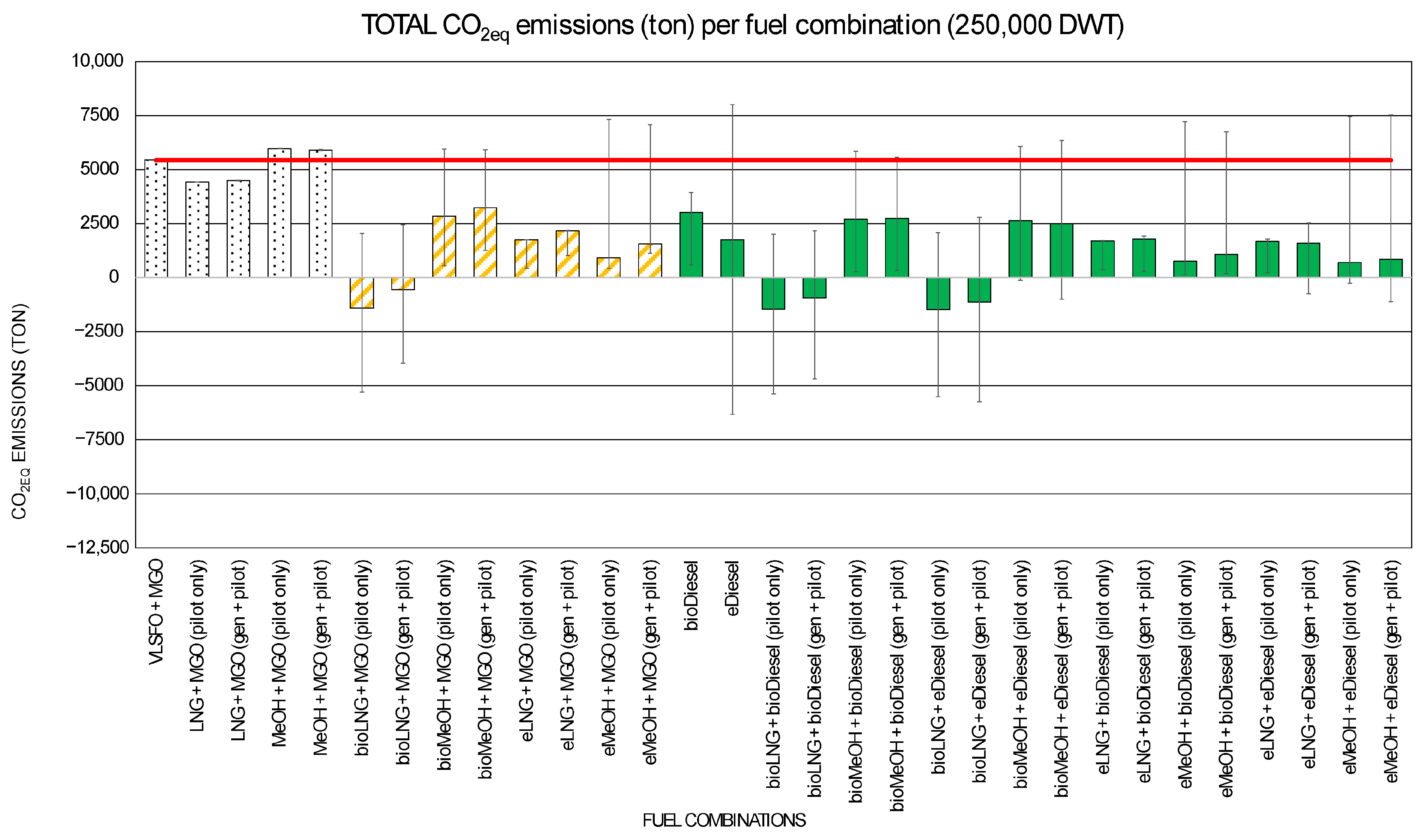
References
- IMO. Resolution MEPC.377(80). Strategy on Reduction of GHG Emissions from Ships. 2023. Available online: https://wwwcdn.imo.org/localresources/en/MediaCentre/PressBriefings/Documents/Resolution%20MEPC.377(80).pdf (accessed on 12 February 2025).
- IMO. IMO Review of Maritime Transport 2023. 2023. Available online: https://unctad.org/system/files/official-document/rmt2023_en.pdf (accessed on 12 February 2025).
- IMO. International Convention for the Prevention of Pollution from Ships. Amended by Resolution MEPC.330(76) and Previous Ones. 2022. Available online: https://wwwcdn.imo.org/localresources/en/KnowledgeCentre/IndexofIMOResolutions/MEPCDocuments/MEPC.330(76).pdf (accessed on 12 February 2025).
- Herdzik, J. Decarbonization of marine fuels—The future of shipping. Energies 2021, 14, 4311. Available online: https://www.researchgate.net/publication/353335037_Decarbonization_of_Marine_Fuels-The_Future_of_Shipping (accessed on 12 February 2025). [CrossRef]
- IMO. Resolution MEPC.364(79). Guidelines on the Method of Calculation of the Attained Energy Efficiency Design Index (EEDI) for New Ships. 2022. Available online: https://wwwcdn.imo.org/localresources/en/KnowledgeCentre/IndexofIMOResolutions/MEPCDocuments/MEPC.364%2879%29.pdf (accessed on 12 February 2025).
- IMO. Resolution MEPC.333(76). Guidelines on the Method of Calculation of the Attained Energy Efficiency Existing Index (EEXI). 2021. Available online: https://wwwcdn.imo.org/localresources/en/KnowledgeCentre/IndexofIMOResolutions/MEPCDocuments/MEPC.333(76).pdf (accessed on 12 February 2025).
- IMO. Resolution MEPC.336(76). Guidelines on Operational Carbon Intensity Indicators and the Calculation Methods (CII). 2021. Available online: https://wwwcdn.imo.org/localresources/en/KnowledgeCentre/IndexofIMOResolutions/MEPCDocuments/MEPC.336(76).pdf (accessed on 12 February 2025).
- Mallouppas, G.; Yfantis, E.A. Decarbonization in shipping industry: A review of research, technology development, and innovation proposals. J. Mar. Sci. Eng. 2021, 9, 415. [Google Scholar] [CrossRef]
- FBI. Iron Ore Market Size, Share & Industry Analysis, By Type (Hematite, Magnetite, and Others), By Application (Steel Production and Others), and Regional Forecast, 2024–2032. 2024. Available online: https://www.fortunebusinessinsights.com/iron-ore-market-108698 (accessed on 12 February 2025).
- Chen, S.; Miao, C.; Zhang, Q. Understanding the evolution of China’s green shipping policies: Evidence by social network analysis. J. Clean. Prod. 2024, 482, 144204. [Google Scholar] [CrossRef]
- Hauhia, E. Bulk Shipping in Numbers and Emissions. SEABER 2021. Available online: https://www.seaber.io/blog/bulk-shipping-numbers-emissions#:~:text=Bulk%20shipping%20accounts%20for%20368,down%20this%20number%20even%20further (accessed on 12 February 2025).
- USDA. Bulk Vessel Fleet; United States Department of Agriculture (USDA): Washington, DC, USA, 2020. Available online: https://agtransport.usda.gov/stories/s/Bulk-Vessel-Fleet-Size-and-Rates/bwaz-8sgs/ (accessed on 17 September 2024).
- IMO. International Maritime Solid Bulk Cargoes Code (IMSBC). 2019. Available online: https://wwwcdn.imo.org/localresources/en/KnowledgeCentre/IndexofIMOResolutions/MSCResolutions/MSC.462(101).pdf (accessed on 12 February 2025).
- BV. 467-NR_PartA_2024-01. 2024. Available online: https://erules.veristar.com/dy/data/bv/pdf/archives/467-NR_PartC_2024-01.pdf (accessed on 12 February 2025).
- CCS. Performances and Services on Ore Carriers. 2024. Available online: https://drive.google.com/drive/folders/1SRH8kc7TX7gUaltsBxQyr8vIpkIRQj-4?usp=drive_link (accessed on 5 March 2024).
- Wang, Y.; Du, L.; Jin, Q. Decarbonization Path of Bulk Carrier Based on Economic Analysis. Ship Boat 2023, 34, 28. [Google Scholar]
- Radonja, R.; Bebić, D.; Glujić, D. Methanol and ethanol as alternative fuels for shipping. Promet-Traffic Transp. 2019, 31, 321–327. [Google Scholar] [CrossRef]
- Kuai, J.; Lu, H. On Design of Large Methanol Dual-Fuel Bulk Carrier. Ship Boat 2024, 35, 109. [Google Scholar]
- Díaz-Cuenca, D. Anteproyecto de un Buque Mineralero ULOC de 400.000 T de Peso Muerto Propulsado Con Metanol. Master’s Thesis, Universidad Politécnica de Madrid, Madrid, Spain, 2024. [Google Scholar]
- Adami, G.; Figari, M. Feasibility analysis of a methanol fuelled bulk carrier. Model. Optim. Ship Energy Syst. 2023. [Google Scholar] [CrossRef]
- Corbett, J.J.; Winebrake, J.J. Life Cycle Analysis of the Use of Methanol for Marine Transportation. Prepared for US Department of Transportation Maritime Administration (MARAD). 2018. Available online: https://www.maritime.dot.gov/sites/marad.dot.gov/files/docs/innovation/meta/11056/marine-methanol-report-20180810final-002.pdf (accessed on 12 February 2025).
- Rachow, M.; Loest, S.; Bramastha, A.D. Analysis of the requirement for the ships using methanol as fuel. Int. J. Mar. Eng. Innov. Res. 2018, 3, 59–68. [Google Scholar] [CrossRef]
- Wang, L.; Lei, J.; Xing, H.; Ji, Y.; Pan, C. Research on the development path of methanol fuel powered ships in China. In Advances in Energy, Environment and Chemical Engineering; CRC Press: Boca Raton, FL, USA, 2022; Volume 1, pp. 515–521. [Google Scholar]
- Harahap, F.; Nurdiawati, A.; Conti, D.; Leduc, S.; Urban, F. Renewable marine fuel production for decarbonised maritime shipping: Pathways, policy measures and transition dynamics. J. Clean. Prod. 2023, 415, 137906. [Google Scholar] [CrossRef]
- Wang, J.; Zhang, W.; Wang, Y. The sensitivity to metocean data on using data-driven methods for a Valemax vessel speed prediction. Ocean Eng. 2022, 252, 111155. [Google Scholar] [CrossRef]
- Dotto, A.; Satta, F.; Campora, U. Energy, environmental and economic investigations of cruise ships powered by alternative fuels. Energy Convers. Manag. 2023, 285, 117011. [Google Scholar] [CrossRef]
- Rivarolo, M.; Rattazzi, D.; Magistri, L.; Massardo, A.F. Multi-criteria comparison of power generation and fuel storage solutions for maritime application. Energy Convers. Manag. 2021, 244, 114506. [Google Scholar] [CrossRef]
- McKinlay, C.J.; Turnock, S.R.; Hudson, D.A. Route to zero emission shipping: Hydrogen, ammonia or methanol? Int. J. Hydrogen Energy 2021, 46, 28282–28297. [Google Scholar] [CrossRef]
- Jimenez, V.J.; Kim, H.; Munim, Z.H. A review of ship energy efficiency research and directions towards emission reduction in the maritime industry. J. Clean. Prod. 2022, 366, 132888. [Google Scholar] [CrossRef]
- Dierickx, J.; Beyen, J.; Block, R.; Hamrouni, M.; Huyskens, P.; Meichelböck, C.; Verhelst, S. Strategies for Introducing Methanol as an Alternative Fuel for Shipping. 7th Transport Research Arena TRA 2018 (TRA 2018); Ghent University: Ghent, Belgium, 2018; pp. 1–10. [Google Scholar]
- Dettner, F.; Hilpert, S. Modelling CO2 emissions and mitigation potential of Northern European shipping. Transp. Res. Part D Transp. Environ. 2023, 119, 103745. [Google Scholar] [CrossRef]
- Svanberg, M.; Ellis, J.; Lundgren, J.; Landälv, I. Renewable methanol as a fuel for the shipping industry. Renew. Sustain. Energy Rev. 2018, 94, 1217–1228. [Google Scholar] [CrossRef]
- Ghosh, A.K. Impact of EEDI and EEXI on Bulk Carriers. In Proceedings of the INEC, Delft, The Netherlands, 8–10 November 2022; Available online: https://www.researchgate.net/publication/364764649_Impact_of_EEDI_and_EEXI_on_Bulk_Carriers (accessed on 12 February 2025).
- Cao, N.N.D.; Andrianov, D.; Vecchi, A.; Davis, D.; Brear, M.J. Achieving affordable, clean shipping by integrating ship design and clean fuels. Transp. Res. Part D Transp. Environ. 2025, 139, 104579. [Google Scholar] [CrossRef]
- Zincir, B.A.; Arslanoglu, Y. Comparative Life Cycle Assessment of Alternative Marine Fuels. Fuel 2024, 358, 129995. [Google Scholar] [CrossRef]
- Nemmour, A.; Inayat, A.; Janajreh, I.; Ghenai, C. Green hydrogen-based E-fuels (E-methane, E-methanol, E-ammonia) to support clean energy transition: A literature review. Int. J. Hydrogen Energy 2023, 48, 29011–29033. [Google Scholar] [CrossRef]
- Calise, F.; Cappiello, F.L.; Cimmino, L.; d’Accadia, M.D.; Vicidomini, M. A review of the state of the art of biomethane production: Recent advancements and integration of renewable energies. Energies 2021, 14, 4895. [Google Scholar] [CrossRef]
- Grabow, L.C.; Mavrikakis, M. Mechanism of methanol synthesis on Cu through CO2 and CO hydrogenation. ACS Catal. 2011, 1, 365–384. [Google Scholar] [CrossRef]
- Subudhi, S.; Saha, K.; Mudgil, D.; Sarangi, P.K.; Srivastava, R.K.; Sarma, M.K. Biomethanol production from renewable resources: A sustainable approach. Environ. Sci. Pollut. Res. 2023, 32, 1–17. [Google Scholar] [CrossRef] [PubMed]
- Dell’Aversano, S.; Villante, C.; Gallucci, K.; Vanga, G.; Di Giuliano, A. E-Fuels: A Comprehensive Review of the Most Promising Technological Alternatives towards an Energy Transition. Energies 2024, 17, 3995. [Google Scholar] [CrossRef]
- Monteiro, M.R.; Kugelmeier, C.L.; Pinheiro, R.S.; Batalha, M.O.; da Silva César, A. Glycerol from biodiesel production: Technological paths for sustainability. Renew. Sustain. Energy Rev. 2018, 88, 109–122. [Google Scholar] [CrossRef]
- Matteo, P.; Marta, Y.; Luis, D.P.; Monica, P.; Robert, E.; Laura, L. JEC Well-to-Tank Report v5; Publications Office of the European Union: Luxembourg, 2020. [Google Scholar] [CrossRef]
- Marrero, Á.; Martínez-López, A. Decarbonization of Short Sea Shipping in European Union: Impact of market and goal based measures. J. Clean. Prod. 2023, 421, 138481. [Google Scholar] [CrossRef]
- Chen, Z. Study on Risk Assessment of Methanol Fueled Ship 2021. Available online: https://commons.wmu.se/cgi/viewcontent.cgi?article=1301&context=msem_dissertations (accessed on 12 February 2025).
- Bayraktar, M.; Yuksel, O.; Pamik, M. An evaluation of methanol engine utilization regarding economic and upcoming regulatory requirements for a container ship. Sustain. Prod. Consum. 2023, 39, 345–356. [Google Scholar] [CrossRef]
- Taghavifar, H.; Perera, L.P. Life cycle emission and cost assessment for LNG-retrofitted vessels: The risk and sensitivity analyses under fuel property and load variations. Ocean Eng. 2023, 282, 114940. [Google Scholar] [CrossRef]
- SEA-LNG.ORG. LNG as a Marine Fuel-the Investment Opportunity Sea\Lng Study-Newbuild 300k dwt Very Large Crude Carrier (VLCC) Sailing from the Arabian Gulf to China. 2020. Available online: https://sea-lng.org/wp-content/uploads/2020/04/SEA-LNGStudyVLCC4_compressed.pdf (accessed on 12 February 2025).
- Karin Andersson CMS. Methanol as a Marine Fuel Report. 2015. Available online: https://www.methanol.org/wp-content/uploads/2018/03/FCBI-Methanol-Marine-Fuel-Report-Final-English.pdf (accessed on 12 February 2025).
- Hagen, G. The State of Methanol as Marine Fuel 2023. Sustain Ships. 2023. Available online: https://www.sustainable-ships.org/stories/2023/methanol-marine-fuel (accessed on 12 February 2025).
- Xing, H.; Stuart, C.; Spence, S.; Chen, H. Alternative fuel options for low carbon maritime transportation: Pathways to 2050. J. Clean. Prod. 2021, 297, 126651. [Google Scholar] [CrossRef]
- Ship & Bunker. 2025. Available online: https://shipandbunker.com/prices/av/global/av-g20-global-20-ports-average (accessed on 12 February 2025).
- Souissi, N. E-Diesel in the Shipping Sector: Prospects and Challenges. OIES Paper: ET. 2024. Available online: https://www.oxfordenergy.org/wpcms/wp-content/uploads/2024/03/ET30-E-diesel-in-the-Shipping-Sector-Final_NS.pdf (accessed on 12 February 2025).
- Gebremariam, S.N.; Marchetti, J.M. Economics of biodiesel production: Review. Energy Convers. Manag. 2018, 168, 74–84. [Google Scholar] [CrossRef]
- Pasha, M.K.; Dai, L.; Liu, D.; Guo, M.; Du, W. An overview to process design, simulation and sustainability evaluation of biodiesel production. Biotechnol. Biofuels 2021, 14, 1–23. [Google Scholar] [CrossRef]
- Qi, M.; Liu, Y.; He, T.; Yin, L.; Shu, C.-M.; Moon, I. System perspective on cleaner technologies for renewable methane production and utilisation towards carbon neutrality: Principles, techno-economics, and carbon footprints. Fuel 2022, 327, 125130. [Google Scholar] [CrossRef]
- Gorre, J.; Ortloff, F.; van Leeuwen, C. Production costs for synthetic methane in 2030 and 2050 of an optimized Power-to-Gas plant with intermediate hydrogen storage. Appl. Energy 2019, 253, 113594. [Google Scholar] [CrossRef]
- Mukherjee, A.; Bruijnincx, P.; Junginger, M. Techno-economic competitiveness of renewable fuel alternatives in the marine sector. Renew. Sustain. Energy Rev. 2023, 174, 113127. [Google Scholar] [CrossRef]
- IRENA. Innovation Outlook: Renewable Methanol; International Renewable Energy Agency (IRENA): Abu Dhabi, United Arab Emirates, 2021. [Google Scholar]
- Vandebroek, L.; Berghmans, J. Safety Aspects of the use of LNG for Marine Propulsion. Procedia Eng. 2012, 45, 21–26. [Google Scholar] [CrossRef]
- IMO. Safety for Ships Using Gases or Other Low-Flashpoint Fuels (IGF Code). 2017. Available online: https://www.imo.org/en/ourwork/safety/pages/igf-code.aspx (accessed on 12 February 2025).
- Ammar, N.R. An environmental and economic analysis of methanol fuel for a cellular container ship. Transp. Res. Part D Transp. Environ. 2019, 69, 66–76. [Google Scholar] [CrossRef]
- IMO. MSC.1-Circ.1621 Guidelines for the Safety of Ships Using Methyl/Ethyl Alcohol as Fuel. 2020. Available online: https://wwwcdn.imo.org/localresources/fr/Documents/MSC.1-Circ.1621.pdf (accessed on 12 February 2025).
- Kawasaki, A.; Liang, C. East China LNG Bunker Prices More Competitive After New Barge Addition: Sources. S&P Global. 2025. Available online: https://www.spglobal.com/commodity-insights/en/news-research/latest-news/lng/012425-east-china-lng-bunker-prices-more-competitive-after-new-barge-addition-sources (accessed on 14 February 2025).
- Ovcina Mandra, J. World’s Largest LNG Bunkering Vessel Refuels First VLCC in Milestone Operation. Offshore Energy. 2023. Available online: https://www.offshore-energy.biz/worlds-largest-lng-bunkering-vessel-refuels-first-vlcc-in-milestone-operation/ (accessed on 12 February 2025).
- Ovcina Mandra, J. China Debuts Its First Methanol Bunkering Vessel. Offshore Energy. 2024. Available online: https://www.offshore-energy.biz/china-debuts-its-first-methanol-bunkering-vessel/ (accessed on 17 February 2025).
- Wijaya, M. Pilbara Clean Fuels to Develop eLNG Bunkering Facility with Oceania Marine. Lloyd’s List. 2023. Available online: https://www.lloydslist.com/LL1143479/Pilbara-Clean-Fuels-to-develop-eLNG-bunkering-facility-with-Oceania-Marine (accessed on 14 February 2025).
- Aluko, L. The Growing Bunker Fuel Opportunity in Brazil. Illuminem. 2023. Available online: https://illuminem.com/illuminemvoices/the-growing-bunker-fuel-opportunity-in-brazil (accessed on 14 February 2025).
- MAN. G80ME-C10.5. 2023. Available online: https://drive.google.com/drive/folders/1SRH8kc7TX7gUaltsBxQyr8vIpkIRQj-4?usp=drive_link (accessed on 4 April 2024).
- MAN. G80ME-C10.5-GI. 2024. Available online: https://man-es.com/applications/projectguides/2stroke/content/printed/G80ME-C10_5-GI.pdf (accessed on 7 March 2025).
- MAN. G80ME-C10.5-LGIM. 2024. Available online: https://drive.google.com/drive/folders/1SRH8kc7TX7gUaltsBxQyr8vIpkIRQj-4?usp=drive_link (accessed on 11 April 2024).
- MAN. GenSet-L23/30H. 2024. Available online: https://www.man-es.com/docs/default-source/document-sync-archive/man-l23-30h-mk-3genset-eng.pdf?sfvrsn=bdb4d4f7_2 (accessed on 1 October 2024).
- MAN. GenSet-L23/30DF. 2024. Available online: https://www.man-es.com/docs/default-source/document-sync-archive/man-l23-30df-eng.pdf?sfvrsn=7a9b60b8_3 (accessed on 1 October 2024).
- Astra Paging Ltd. VesselFinder. 2024. Available online: https://www.vesselfinder.com/vessels/details/9806873 (accessed on 14 November 2024).
- SeaDistance. SEA-DISTANCE.ORG. 2024. Available online: https://sea-distances.org/ (accessed on 8 November 2024).
- ABS. Ocean Pacific (Ore Carrier). American Bureau of Shipping. 2024. Available online: https://absrecord.eagle.org/#/absrecord/details (accessed on 31 October 2024).
- ABS. Ore Wuhan (Ore Carrier). American Bureau of Shipping. 2024. Available online: https://absrecord.eagle.org/#/absrecord/details (accessed on 31 October 2024).
- ABS. Ore Zhanjiang (Ore Carrier). American Bureau of Shipping. 2024. Available online: https://absrecord.eagle.org/#/absrecord/details (accessed on 31 October 2024).
- Wikipedia. Chinamax. 2024. Available online: https://en.wikipedia.org/wiki/Chinamax (accessed on 30 August 2024).
- RINA. Yuan He Hai (ULOC). In Significant Ships 2018; The Royal Institution of Naval Architect: London, UK, 2018; pp. 82–83. [Google Scholar]
- Zamboni, G.; Scamardella, F.; Gualeni, P.; Canepa, E. Comparative analysis among different alternative fuels for ship propulsion in a well-to-wake perspective. Heliyon 2024, 10, e26016. [Google Scholar] [CrossRef]
- EU. Regulation (EU) 2023/1805 of the European Parliament and of the Council of 13 September 2023 on the Use of Renewable and Low-Carbon Fuels in Maritime Transport, and Amending Directive 2009/16/EC. 2023. Available online: https://eur-lex.europa.eu/legal-content/EN/TXT/PDF/?uri=CELEX:32023R1805 (accessed on 12 February 2025).
- Yuan, J.; Ng, S.H.; Sou, W.S. Uncertainty quantification of CO2 emission reduction for maritime shipping. Energy Policy 2016, 88, 113–130. [Google Scholar] [CrossRef]
- EU. Directive (EU) 2018/2001 of the European Parliament and of the Council of 11 December 2018 on the Promotion of the Use of Energy from Renewable Sources. 2018. Available online: https://eur-lex.europa.eu/legal-content/EN/TXT/PDF/?uri=CELEX:32018L2001 (accessed on 12 February 2025).
- EU. JEC Well-to-Tank Report v5. Luxembourg. 2020. Available online: https://publications.jrc.ec.europa.eu/repository/handle/JRC119036 (accessed on 12 February 2025).
- Carvalho, F.; Müller-Casseres, E.; Poggio, M.; Nogueira, T.; Fonte, C.; Wei, H.K.; Portugal-Pereira, J.; Rochedo, P.R.R.; Szklo, A.; Schaeffer, R. Prospects for carbon-neutral maritime fuels production in Brazil. J. Clean. Prod. 2021, 326, 129385. [Google Scholar] [CrossRef]
- Hörteborn, A.; Hassellöv, I.-M. Economic incentives and technological limitations govern environmental impact of LNG feeder vessels. J. Clean. Prod. 2023, 429, 139461. [Google Scholar] [CrossRef]
- Kuittinen, N.; Koponen, P.; Vesala, H.; Lehtoranta, K. Methane slip and other emissions from newbuild LNG engine under real-world operation of a state-of-the art cruise ship. Atmos. Environ. X 2024, 23, 100285. [Google Scholar] [CrossRef]
- Lehtoranta, K.; Kuittinen, N.; Vesala, H.; Koponen, P. Methane Emissions from a State-of-the-Art LNG-Powered Vessel. Atmosphere 2023, 14, 825. [Google Scholar] [CrossRef]
- Kuittinen, N.; Heikkilä, M.; Jalkanen, J.-P.; Aakko-Saksa, P.; Lehtoranta, K. Methane slip emissions from LNG vessels-review. In Proceedings of the 30th CIMAC World Congress, Busan, Republic of Korea, 12–16 June 2023; p. 629. [Google Scholar]
- IMO. Resolution MEPC 391(81). Study of Actual Methane Slip from Newbuild LNG Engine of a State-of-the Art Cruise Ship. 2024. Available online: https://greenray-project.eu/wp-content/uploads/2024/11/MEPC-82-INF.16-Study-of-actual-methane-slip-from-newbuild-LNG-engine-ofa-state-of-the-art-cruise-ship-Finland-002.pdf (accessed on 12 February 2025).
- Atkins, P.; Milton, G.; Atkins, A.; Morgan, R. A local ecosystem assessment of the potential for net negative heavy-duty truck greenhouse gas emissions through biomethane upcycling. Energies 2021, 14, 806. [Google Scholar] [CrossRef]
- Adami, G.; Figari, M. Multi-Parametric Methodology for the Feasibility Assessment of Alternative-Fuelled Ships. J. Mar. Sci. Eng. 2024, 12, 905. [Google Scholar] [CrossRef]
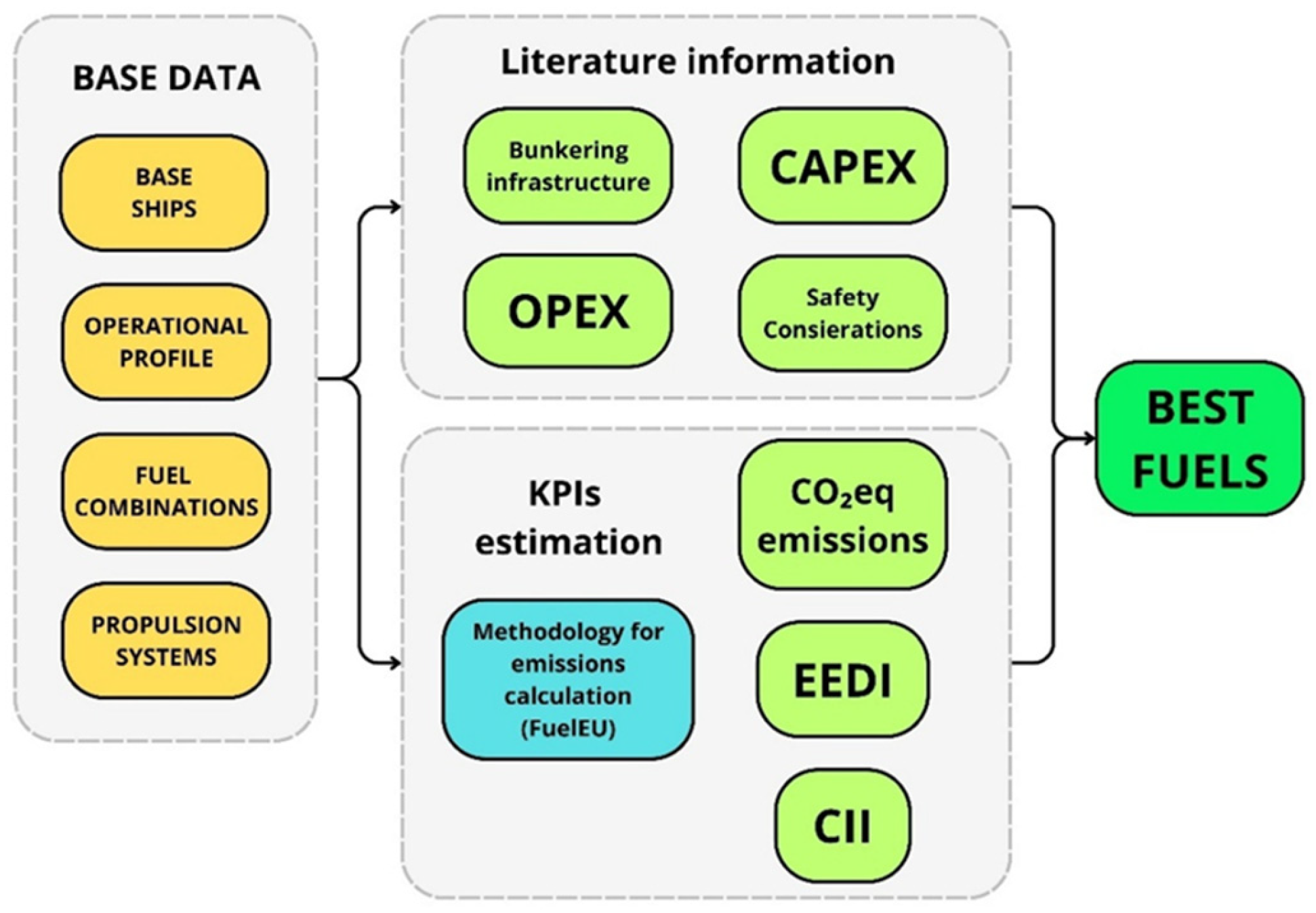


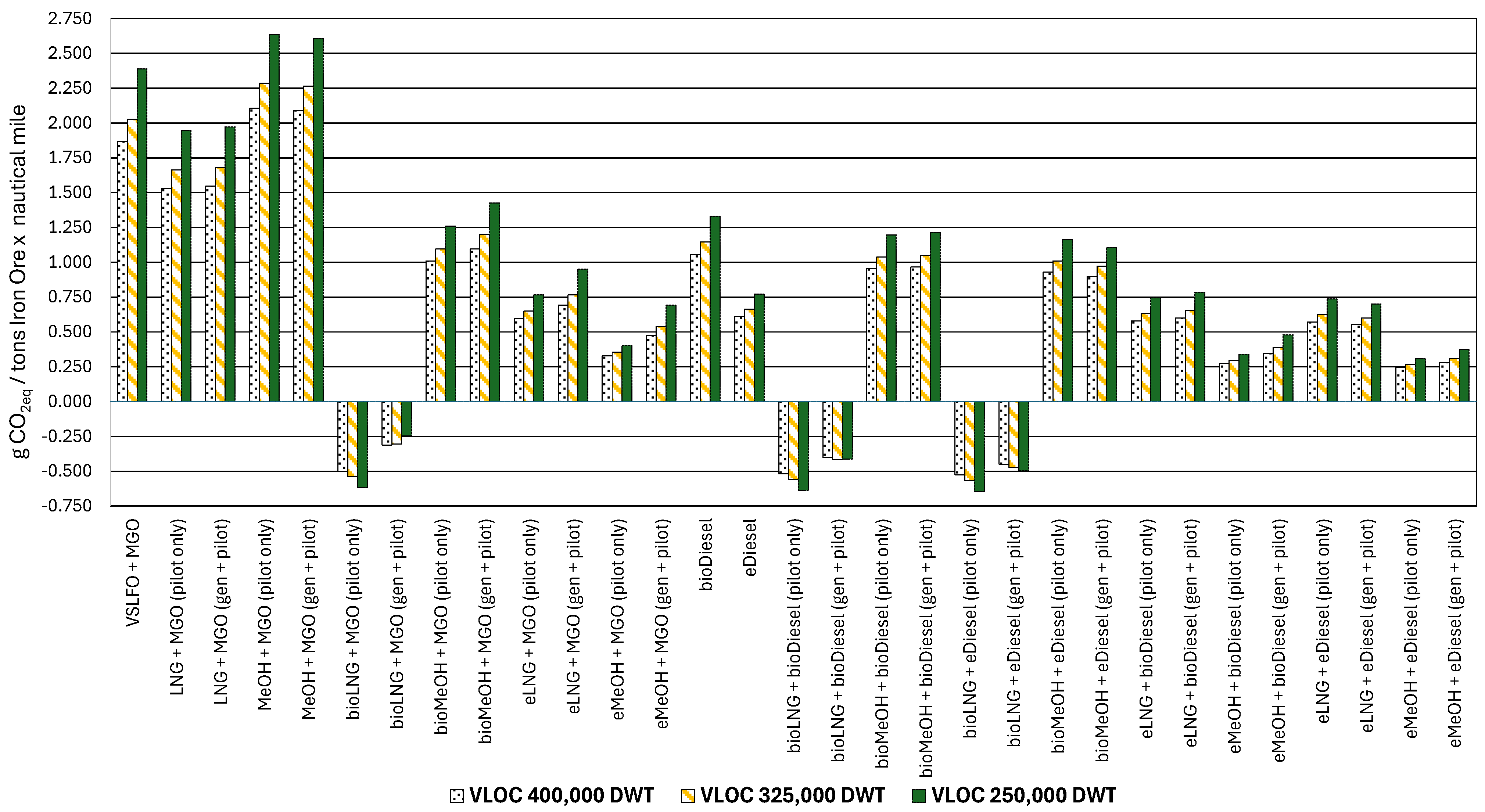
| Fuel | Reference Date of the Current Cost | Actual Cost (USD/t) | Actual Cost (USD/GJ) | Expected Cost 2050 (USD/t) | Expected Cost 2050 (USD/GJ) | Reference |
|---|---|---|---|---|---|---|
| VLSFO (0.5% S) | 12 February 2025 | 570–632 | 14.1–15.6 | - | - | [51] |
| MGO (0.1% S) | 12 February 2025 | 726–817 | 17.0–19.1 | - | - | [51] |
| eDiesel | 2023 | 1778–5495 | 41.6–128.7 | 800–4750 | 18.7–111.2 | [52] |
| bioDiesel | 2021 | 632–2415 | 14.8–56.5 | - | - | [53,54] |
| LNG | 12 February 2025 | 725–1041 | 14.8–21.2 | - | - | [51] |
| eLNG | 2022 | 3678–21,142 | 74.9–430.6 | 972–8362 | 19.8–170.3 | [55,56] |
| bioLNG | 2022 | 1473–2946 | 30.0–60.0 | - | - | [57] |
| MeOH | 12 February 2025 | 360–468 | 18.1–23.5 | - | - | [51] |
| eMeOH | 2021 | 820–2380 | 41.2–119.6 | 250–630 | 12.6–31.7 | [58] |
| bioMeOH | 2021 | 327–1013 | 16.4–50.9 | 227–884 | 11.4–44.4 | [58] |
| Vessel Type | Departure | Arrival | Distance (km) | Sailing Time (Days) |
|---|---|---|---|---|
| 400,000 & 325,000 DWT | Port Tubarao (Brazil) | Port Tianjin (China) | 18,318 | 32.5 |
| 250,000 DWT | Port Headland (Australia) | Port Tianjin (China) | 7400 | 13.3 |
| Operational Conditions | Nº ME | RM (%) | Nº GE | RN (%) | Time at Port (Days) |
|---|---|---|---|---|---|
| Sailing Full Load | 1/1 | 85 | 1/3 | 85 | - |
| Sailing Ballast Load | 1/1 | 50 | 1/3 | 85 | - |
| Loading/Unloading | 0/1 | - | 2/3 | 85 | 2 × 2.5 |
| Stay at Port | 0/1 | - | 1/3 | 75 | 2 × 0.5 |
| Analysis Scenarios | Main Engine | MCR (kW) | Maximum Cargo Capacity (t) | Main Fuel Consumption (t) | MGO/Diesel Consumption (t) |
|---|---|---|---|---|---|
| 400,000 DWT (VLSFO) | 7G80ME-C10.5 | 24,200 | 392,056 | 4059.0 | 385.2 |
| 400,000 DWT (LNG) | 7G80ME-C10.5-GI | 24,200 | 392,813 | 3292.8 + 312.3 | 81.7 |
| 400,000 DWT (MeOH) | 7G80ME-C10.5-LGIM | 24,200 | 387,457 | 7961.6 + 812.0 | 269.7 |
| 325,000 DWT (VLSFO) | 7G80ME-C10.5 | 21,000 | 317,863 | 3522.3 | 385.2 |
| 325,000 DWT (LNG) | 7G80ME-C10.5-GI | 21,000 | 318,529 | 2857.4 + 312.3 | 70.9 |
| 325,000 DWT (MeOH) | 7G80ME-C10.5-LGIM | 21,000 | 313,815 | 6908.8 + 812.0 | 234.0 |
| 250,000 DWT (VLSFO) | 6G80ME-C10.5 | 18,000 | 247,145 | 1234.7 | 190.2 |
| 250,000 DWT (LNG) | 6G80ME-C10.5-GI | 18,000 | 247,389 | 1001.7 + 154.2 | 24.9 |
| 250,000 DWT (MeOH) | 6G80ME-C10.5-LGIM | 18,000 | 245,665 | 2421.9 + 400.9 | 82.0 |
| Fuel | LHV (MJ/kg) | ρ (kg/m3) | Carbon Content | Cf (m CO2/m Fuel) |
|---|---|---|---|---|
| VLSFO | 40.50 | 950 | 0.8594 | 3.151 |
| Diesel/MGO | 42.70 | 900 | 0.8744 | 3.206 |
| LNG | 48.00 | 450 | 0.7500 | 2.750 |
| MeOH | 19.90 | 790 | 0.3750 | 1.375 |
| Chemical Compound | GWP100 (m CO2eq/m Compound) |
|---|---|
| CO2 | 1 |
| CH4 | 25 |
| N2O | 298 |
| Fuel | LHV (MJ/kg) | CfCO2 (kg CO2/kg Fuel) | E (gCO2eq/MJ) | (gCO2eq/MJ) | ||||
|---|---|---|---|---|---|---|---|---|
| Min | WtT Selected | Max | Min | WtT Selected | Min | |||
| VLSFO | 40.5 | 3.151 | 13.2 | 13.2 | 13.2 | 13.2 | 13.2 | 13.2 |
| MGO | 42.7 | 3.206 | 13.1 | 14.4 | 17.0 | 13.1 | 14.4 | 17.0 |
| LNG | 49.1 | 2.750 | 16.6 | 16.6 | 16.6 | 16.6 | 16.6 | 16.6 |
| MeOH | 19.9 | 1.375 | 31.3 | 31.3 | 31.3 | 31.3 | 31.3 | 31.3 |
| bioDiesel | 42.7 | 3.206 | 8.3 | 48.4 | 63.3 | −66.3 | −26.2 | −11.3 |
| bioLNG | 49.1 | 2.750 | −98.7 | −30.1 | 30.5 | −154.7 | −86.1 | −25.5 |
| bioMeOH | 19.9 | 1.375 | 4.4 | 45.0 | 100 | −64.7 | −24.1 | 30.9 |
| eDiesel | 42.7 | 3.206 | −105.1 | 27.5 | 130.3 | −180.2 | −47.6 | 55.2 |
| eLNG | 49.1 | 2.750 | 2.4 | 25.3 | 25.3 | −53.6 | −30.7 | −30.7 |
| eMeOH | 19.9 | 1.375 | 1.8 | 10.5 | 124.3 | −67.3 | −58.6 | 55.2 |
| Fuel | Fuel Consumer Unit Class | (m CO2/m Fuel) | (m CH4/m Fuel) | (m N2O/m Fuel) | (m CO2eq/m Fuel) | * (%) |
|---|---|---|---|---|---|---|
| VLSFO | ALL ICEs | 3.151 | 0.00005 | 0.00018 | 3.206 | 0 |
| MGO | ALL ICEs | 3.206 | 0.00005 | 0.00018 | 3.261 | 0 |
| LNG | LNG Diesel | 2.750 | 0 | 0.00011 | 2.783 | 0.2 |
| LNG | LNG Otto (M) | 2.750 | 0 | 0.00011 | 2.783 | 3.1 |
| MeOH | ALL ICEs | 1.375 | 0 | 0 | 1.375 | 0 |
| bioDiesel | ALL ICEs | 3.206 | 0.00005 | 0.00018 | 3.261 | 0 |
| bioLNG | LNG Diesel | 2.750 | 0 | 0.00011 | 2.783 | 0.2 |
| bioLNG | LNG Otto (M) | 2.750 | 0 | 0.00011 | 2.783 | 3.1 |
| bioMeOH | ALL ICEs | 1.375 | 0 | 0 | 1.375 | 0 |
| eDiesel | ALL ICEs | 3.206 | 0.00005 | 0.00018 | 3.261 | 0 |
| eLNG | LNG Diesel | 2.750 | 0 | 0.00011 | 2.783 | 0.2 |
| eLNG | LNG Otto (M) | 2.750 | 0 | 0.00011 | 2.783 | 3.1 |
| eMeOH | ALL ICEs | 1.375 | 0 | 0 | 1.375 | 0 |
| Fuel Combinations | 400,000 DWT Emissions Reduction (%) | 325,000 DWT Emissions Reduction (%) | 250,000 DWT Emissions Reduction (%) |
|---|---|---|---|
| 1. VLSFO + MGO | 0% | 0% | 0% |
| 2. LNG + MGO (pilot only) | −18% | −18% | −19% |
| 3. LNG + MGO (gen + pilot) | −17% | −17% | −17% |
| 4. MeOH + MGO (pilot only) | 11% | 11% | 10% |
| 5. MeOH + MGO (gen + pilot) | 11% | 10% | 9% |
| 6. bioLNG + MGO (pilot only) | −127% | −127% | −126% |
| 7. bioLNG + MGO (gen + pilot) | −117% | −115% | −110% |
| 8. bioMeOH + MGO (pilot only) | −47% | −47% | −48% |
| 9. bioMeOH + MGO (gen + pilot) | −42% | −41% | −41% |
| 10. eLNG + MGO (pilot only) | −68% | −68% | −68% |
| 11. eLNG + MGO (gen + pilot) | −63% | −62% | −60% |
| 12. eMeOH + MGO (pilot only) | −83% | −83% | −83% |
| 13. eMeOH + MGO (gen + pilot) | −75% | −74% | −71% |
| 14. bioDiesel | −43% | −43% | −44% |
| 15. eDiesel | −67% | −67% | −68% |
| 16. bioLNG + bioDiesel (pilot only) | −128% | −128% | −127% |
| 17. bioLNG + bioDiesel (gen + pilot) | −122% | −121% | −117% |
| 18. bioMeOH + bioDiesel (pilot only) | −49% | −49% | −50% |
| 19. bioMeOH + bioDiesel (gen + pilot) | −49% | −49% | −49% |
| 20. bioLNG + eDiesel (pilot only) | −128% | −128% | −127% |
| 21. bioLNG + eDiesel (gen + pilot) | −124% | −123% | −121% |
| 22. bioMeOH + eDiesel (pilot only) | −51% | −51% | −52% |
| 23. bioMeOH + eDiesel (gen + pilot) | −52% | −53% | −54% |
| 24. eLNG + bioDiesel (pilot only) | −69% | −69% | −69% |
| 25. eLNG + bioDiesel (gen + pilot) | −68% | −68% | −67% |
| 26. eMeOH + bioDiesel (pilot only) | −86% | −86% | −86% |
| 27. eMeOH + bioDiesel (gen + pilot) | −82% | −81% | −80% |
| 28. eLNG + eDiesel (pilot only) | −69% | −69% | −69% |
| 29. eLNG + eDiesel (gen + pilot) | −70% | −70% | −71% |
| 30. eMeOH + eDiesel (pilot only) | −87% | −87% | −87% |
| 31. eMeOH + eDiesel (gen + pilot) | −85% | −85% | −85% |
| Vessel Segment (DWT) | Required EEDI (10%) 1 January 2015 | Required EEDI (20%) 1 January 2020 | Required EEDI (30%) 1 January 2025 | Required EEDI (50%) 1 January 2030 |
|---|---|---|---|---|
| 400,000 | 2.187 | 1.944 | 1.701 | 1.215 |
| 325,000 | 2.187 | 1.944 | 1.701 | 1.215 |
| 250,000 | 2.304 | 2.048 | 1.792 | 1.280 |
| Fuel Combination | 400,000 DWT | 325,000 DWT | 250,000 DWT |
|---|---|---|---|
| VLSFO + MGO | 1.917 | 2.067 | 2.330 |
| LNG + MGO (pilot only) | 1.387 (−28%) | 1.495 (−28%) | 1.684 (−28%) |
| LNG + MGO (gen + pilot) | 1.423 (−26%) | 1.539 (−26%) | 1.741 (−25%) |
| MeOH + MGO (pilot only) | 1.766 (−8%) | 1.903 (−8%) | 2.145 (−8%) |
| MeOH + MGO (gen + pilot) | 1.777 (−7%) | 1.917 (−7%) | 2.163 (−7%) |
| Vessel Segment (DWT) | Required CII (5%) 1 January 2023 | Required CII (7%) 1 January 2024 | Required CII (9%) 1 January 2025 | Required CII (11%) 1 January 2026 |
|---|---|---|---|---|
| 400,000 | 1.848 | 1.809 | 1.771 | 1.732 |
| 325,000 | 1.848 | 1.809 | 1.771 | 1.732 |
| 250,000 | 1.979 | 1.937 | 1.896 | 1.854 |
| Fuel Combinations | 400,000 DWT | 325,000 DWT | 250,000 DWT | |||
|---|---|---|---|---|---|---|
| CII | Rating | CII | Rating | CII | Rating | |
| VLSFO + MGO | 1.540 | 0.87 (B) | 1.667 | 0.94 (C) | 1.958 | 1.03 (C) |
| LNG + MGO (pilot only) | 1.118 (−27%) | 0.63 (A) | 1.209 (−27%) | 0.68 (A) | 1.417 (−28%) | 0.75 (A) |
| LNG + MGO (gen + pilot) | 1.159 (−25%) | 0.65 (A) | 1.260 (−24%) | 0.71 (A) | 1.498 (−23%) | 0.79 (A) |
| MeOH + MGO (pilot only) | 1.420 (−8%) | 0.80 (A) | 1.536 (−8%) | 0.87 (B) | 1.803 (−8%) | 0.95 (C) |
| MeOH + MGO (gen + pilot) | 1.433 (−7%) | 0.81 (A) | 1.552 (−7%) | 0.88 (B) | 1.828 (−7%) | 0.96 (C) |
Disclaimer/Publisher’s Note: The statements, opinions and data contained in all publications are solely those of the individual author(s) and contributor(s) and not of MDPI and/or the editor(s). MDPI and/or the editor(s) disclaim responsibility for any injury to people or property resulting from any ideas, methods, instructions or products referred to in the content. |
© 2025 by the authors. Licensee MDPI, Basel, Switzerland. This article is an open access article distributed under the terms and conditions of the Creative Commons Attribution (CC BY) license (https://creativecommons.org/licenses/by/4.0/).
Share and Cite
Díaz-Cuenca, D.; Villalba-Herreros, A.; Leo, T.J.; d’Amore-Domenech, R. Alternative Fuels in the Maritime Industry: Emissions Evaluation of Bulk Carrier Ships. J. Mar. Sci. Eng. 2025, 13, 1313. https://doi.org/10.3390/jmse13071313
Díaz-Cuenca D, Villalba-Herreros A, Leo TJ, d’Amore-Domenech R. Alternative Fuels in the Maritime Industry: Emissions Evaluation of Bulk Carrier Ships. Journal of Marine Science and Engineering. 2025; 13(7):1313. https://doi.org/10.3390/jmse13071313
Chicago/Turabian StyleDíaz-Cuenca, Diego, Antonio Villalba-Herreros, Teresa J. Leo, and Rafael d’Amore-Domenech. 2025. "Alternative Fuels in the Maritime Industry: Emissions Evaluation of Bulk Carrier Ships" Journal of Marine Science and Engineering 13, no. 7: 1313. https://doi.org/10.3390/jmse13071313
APA StyleDíaz-Cuenca, D., Villalba-Herreros, A., Leo, T. J., & d’Amore-Domenech, R. (2025). Alternative Fuels in the Maritime Industry: Emissions Evaluation of Bulk Carrier Ships. Journal of Marine Science and Engineering, 13(7), 1313. https://doi.org/10.3390/jmse13071313








